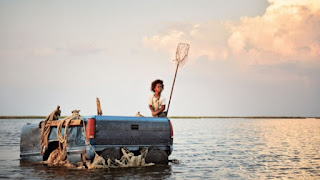Beasts
of the Southern Wild is a refreshing, thought provoking, and wholly
original film.
Hushpuppy is six. She lives in a place called The Bathtub, which I took to be
a postapocalyptic community somewhere in the bayous of Louisiana (Its true
nature is revealed later in the film, but I’ll leave that for you to
discover.). She lives in a shack
about fifty feet from the shack of her father, Wink, who is definitely an
alcoholic and possibly insane. The
whole place is just one big storm away from disappearing under the brackish
waters of the bayou, never to return.
Legend has it that the ice caps are melting and, when they do, giant
beasts called aurochs will emerge from their long sleep and consume everything
in their path.
This may not sound like the setup for a beautiful and
moving picture. Yet, there it is. Beasts
of the Southern Wild is shot beautifully, even when it’s shooting scenes of
squalor and fear. The Bathtub and
its population have their own shoddy dignity, and Hushpuppy carries the
resourcefulness and self-possession of backwoods royalty. She’s only six years old, and she
thinks and acts like a six-year-old, but she’s a leader.
The film itself unfolds in its own time, in its own
way. There is a three-act story
here, but you have to look for it.
Beasts of the Southern Wild
feels more like a chronicle of time, place, and person than a plot. As I burrowed into The Bathtub and came
to understand its denizens, I came to feel at home. As events played out in reasonable succession, I came to
care about Hushpuppy and the people around her. As the film concluded, I was almost sorry it was over. This doesn’t imply that Beasts of the Southern Wild is a
feel-good movie or that it shrinks from despair. It’s just that the film feels true, and worthwhile, and
beautiful. Time with Beasts of the Southern Wild is time well
spent.

